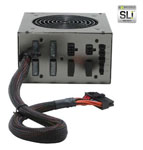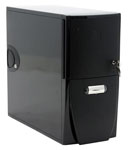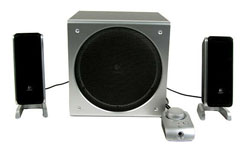Mid-Range Buyer's Guide, September 2005
by Jarred Walton on September 19, 2005 12:05 AM EST- Posted in
- Guides
Remaining Recommendations
We've covered the major components of the systems, and all that remains are the accessories. There isn't much new to say on the majority of these parts, and our Price Guides cover each area in more detail. Here are the rest of the components, and for most of them personal preference will play a large part in determining what you get. If you want higher quality speakers, you'll need to spend more money. A faster hard drive (or multiple hard drives) is definitely an option, but for most people it won't have a major impact - we generally prefer storage capacity and low noise levels over a small increase in HDD performance. Case, power supply, and optical storage choices round out the final components.
We have two lists of the remaining parts, one for the gaming configurations and the other for the office setups. We tried to balance the final system cost as much as possible, but the simple truth is that a good gaming/enthusiast setup requires more expensive parts than a business configuration. You can always downgrade some of the components to cheaper alternatives, but if we were building a computer for our own use, we'd rather save up for better quality than settle for lower cost.
Gaming Components:
Office Components:
Most of the choices should be pretty self-explanatory, so we just want to touch on the important areas. First, we've chosen to use a higher end power supply for the gaming configuration. Many people think that the modular power supplies are nice as they help to eliminate cable clutter, though some of the cables are a little stiff and can be difficult to route. The SunBeam 550W that we've chosen includes two PCIe power connectors, which would be required for an SLI configuration. (If you're running high-end components in an SLI setup, we'd think twice about using simple molex-to-PCIe adapters.) $86 for a power supply is a lot of money, but that's better than having random system crashes caused by exceeding the PSU load levels. Antec, OCZ, Enermax, and a few others also have some SLI-ready power supplies, though most cost upwards of $100 (and we'd avoid anything claiming SLI readiness that costs under $75).
Both setups use pretty low-end speaker arrangements. The Z-3e speakers sound good for the price, but they're not at the level of something like the Z-5500 or Klipsch, and true audiophiles would scoff at either of those "high end" choices that we just mentioned. If you're serious about audio quality, you probably already know more than what we typically cover in the Buyer's Guides. (The entire Logitech line of speakers is pretty reasonable if you're looking for other options. We've recommended them many times in the past, and this isn't really a change in recommendation so much as an alternative that you might consider.) We also stick with the integrated audio solutions for all of the systems, though the Karajan adapter of the DFI board certainly offers the best overall quality of the four boards. While there is a difference between integrated audio and discrete audio solutions, you'll need better speakers before it really begins to matter.
Our hard drive and optical drive selections are essentially a toss up. Our last Hard Drive Roundup showed that SATA 3.0Gbps drives were faster in some areas, NCQ could help out in certain tests as well, but there was no clear victor. All things being equal, we'll go for cost per GB, and for the dual-core systems, we'll also grab an NCQ enabled drive. Some people would rather have a better warranty like the 5-year Seagate and Western Digital Raptor or Caviar RE. If you ever need to use that warranty, though, you'll probably be pretty unhappy - the data on the drive is almost always more important than the drive itself. That's why a good backup strategy is important, and the DVDR drives that we've listed will get you started. We should also mention that firmware updates to the NEC 3540A and BenQ DW1640 drives have ironed out most of the media compatibility issues, so either drive is a good purchase.
We've covered the major components of the systems, and all that remains are the accessories. There isn't much new to say on the majority of these parts, and our Price Guides cover each area in more detail. Here are the rest of the components, and for most of them personal preference will play a large part in determining what you get. If you want higher quality speakers, you'll need to spend more money. A faster hard drive (or multiple hard drives) is definitely an option, but for most people it won't have a major impact - we generally prefer storage capacity and low noise levels over a small increase in HDD performance. Case, power supply, and optical storage choices round out the final components.
We have two lists of the remaining parts, one for the gaming configurations and the other for the office setups. We tried to balance the final system cost as much as possible, but the simple truth is that a good gaming/enthusiast setup requires more expensive parts than a business configuration. You can always downgrade some of the components to cheaper alternatives, but if we were building a computer for our own use, we'd rather save up for better quality than settle for lower cost.
 |
 |
 |
| Click images to enlarge. | ||
Gaming Components:
| Hard Drive: | Western Digital SATA II 160GB 7200RPM 8MB Caviar SE | $81 |
| Optical Drive: | BenQ DW1640 Black (OEM) | $43 |
| Case: | Cooler Master Cavalier 3 CAV-T03-UK | $76 |
| Power Supply: | SunBeam 550W NUUO SUNNU550-US-BK Modular PSU | $86 |
| Speakers: | Labtec ARENA 685 5.1 Speakers | $48 |
| Keyboard and Mouse: | Logitech Internet Pro Desktop | $23 |
 |
 |
 |
| Click images to enlarge. | ||
Office Components:
| Hard Drive: | Hitachi SATA 250GB 7200RPM 8MB Deskstar 7K250 NCQ | $120 |
| Optical Drive: | NEC 3540A Black (OEM) | $42 |
| Case and Power Supply: | Antec Sonata II + SmartPower 2.0 450W PSU | $115 |
| Speakers: | Logitech Z-3e 2.1 Speakers | $73 |
| Keyboard and Mouse: | Logitech Internet Pro Desktop | $23 |
Most of the choices should be pretty self-explanatory, so we just want to touch on the important areas. First, we've chosen to use a higher end power supply for the gaming configuration. Many people think that the modular power supplies are nice as they help to eliminate cable clutter, though some of the cables are a little stiff and can be difficult to route. The SunBeam 550W that we've chosen includes two PCIe power connectors, which would be required for an SLI configuration. (If you're running high-end components in an SLI setup, we'd think twice about using simple molex-to-PCIe adapters.) $86 for a power supply is a lot of money, but that's better than having random system crashes caused by exceeding the PSU load levels. Antec, OCZ, Enermax, and a few others also have some SLI-ready power supplies, though most cost upwards of $100 (and we'd avoid anything claiming SLI readiness that costs under $75).
Both setups use pretty low-end speaker arrangements. The Z-3e speakers sound good for the price, but they're not at the level of something like the Z-5500 or Klipsch, and true audiophiles would scoff at either of those "high end" choices that we just mentioned. If you're serious about audio quality, you probably already know more than what we typically cover in the Buyer's Guides. (The entire Logitech line of speakers is pretty reasonable if you're looking for other options. We've recommended them many times in the past, and this isn't really a change in recommendation so much as an alternative that you might consider.) We also stick with the integrated audio solutions for all of the systems, though the Karajan adapter of the DFI board certainly offers the best overall quality of the four boards. While there is a difference between integrated audio and discrete audio solutions, you'll need better speakers before it really begins to matter.
Our hard drive and optical drive selections are essentially a toss up. Our last Hard Drive Roundup showed that SATA 3.0Gbps drives were faster in some areas, NCQ could help out in certain tests as well, but there was no clear victor. All things being equal, we'll go for cost per GB, and for the dual-core systems, we'll also grab an NCQ enabled drive. Some people would rather have a better warranty like the 5-year Seagate and Western Digital Raptor or Caviar RE. If you ever need to use that warranty, though, you'll probably be pretty unhappy - the data on the drive is almost always more important than the drive itself. That's why a good backup strategy is important, and the DVDR drives that we've listed will get you started. We should also mention that firmware updates to the NEC 3540A and BenQ DW1640 drives have ironed out most of the media compatibility issues, so either drive is a good purchase.










56 Comments
View All Comments
JarredWalton - Tuesday, September 20, 2005 - link
This recommendation has nothing to do with marketing. Does anyone *need* this fast of a card? Well, if you want to play certain games at 1600x1200 (or 1920x1200), then yes, this level of hardware will be required. If you're okay with 1024x768, then the 7800GT is overkill. However, you're talking about spending $300 for a new GPU. That would get you a 6800GT, X800XL, or X850Pro. For 25% more money on the GPU, you will get a card that is http://www.anandtech.com/video/showdoc.aspx?i=2496...">far more than 25% faster in most 3D games. (Unless you continue to run at 1024x768 without AA enabled.)That's not marketing, that's the simple truth. A 7800GT is 25 to 75% faster than the current $300 cards. If you've already got a good gaming system, there's no need to upgrade right now. If you're running two year old hardware and want to upgrade to something faster, though, why come up a bit short? It's not like I'm suggesting that you spend the extra $100+ to go from a 6800GT to a 6800Ultra or from an X800Pro to an X800XTPE. You *can* cut costs on the hardware, but if anything I'd ditch the SLI board and enthusiast RAM rather than downgrading the GPU - at least in a gaming system.
jonah42 - Monday, September 19, 2005 - link
Yes a good guide, some thought provoking choices but you have forgotten the importance of a good sound card. You do not mention the quality of the onboard sound of the DFI board - I think goud sound quality realy brings a game to life - adding to the cinematic feeling greatly. If you want good multichannel placement then the Audigy 4 is a must, for best sound qaulity then a good Envy24 based card is recommended - eg Audotrak Prodigy or equivalent.PrinceGaz - Monday, September 19, 2005 - link
Onboard sound quality is more than good enough for most people these days, and if they want improved sound quality it would be better spent on higher-quality speakers than on a discrete sound-card.For gamers an Audigy 4 is unnecessary, a cheap Audigy 2 or Audigy 2 ZS would be perfectly adequate. Or you could always fall for Creative's hype and blow a fortune on an X-Fi of course. I'm perfectly happy with the sound from the Karajan module on my DFI board, but I do occasionally consider getting an Audigy 2 [ZS] for games.
yacoub - Monday, September 19, 2005 - link
BlueGears X-Mystique - $99 and I believe it does not resample sources like the Creative cards do. If it does, there are other options out there for around the same price that don't.So anyway, you're looking at an affordable non-Creative soundcard that offers great sound reproduction. It's hard to ask for more than that short of a pro-level card. :)
ceefka - Monday, September 19, 2005 - link
I agree with your point of view here, though I wouldn't recommend a board that doesn't feature Firewire. Sure it is possible to buy a PCI card for Firewire (where are the PCI-E 1x/2x Firewire cards by the way?) but you might want to save the ever diminishing number of PCI-slots for something else than a PCI-card?ceefka - Monday, September 19, 2005 - link
Forget what I said. I just found one from http://www.siig.com/product.asp?catid=14&pid=9...">SIIGceefka - Monday, September 19, 2005 - link
but you might want to save the ever diminishing number of PCI-slots for something else than a PCI-card?bummer, that shoud have read:
but you might want to save the ever diminishing number of PCI-slots for something else than a Firewire PCI-card?
flatblastard - Monday, September 19, 2005 - link
.....but I can't seem to get past the fact that the system must be overclocked to actually reach the level of "Mid-range". Buying the exact parts in the guide and build without overclocking will result in an "entry-level" rig. I know we don't have to buy EXACTLY the same parts, but still, I wouldn't call that a mid range rig, not by a long shot.yacoub - Monday, September 19, 2005 - link
Or just don't go dual-core if you want more CPU speed -and- the faster GPU. :)Sure if you encode Div-X while you game it wouldn't perform as well but honestly people who does that??
JarredWalton - Monday, September 19, 2005 - link
It doesn't *have* to be overclocked. I've got an article that will show the performance scaling of several options, and while the overclocked 3200+ is definitely faster, I'd take a stock 3000+ with a 7800GT over a 3800+ with an X800Pro. I mean, do you want 30% faster frame rates at 1024x768 (which is what you'd get with a faster CPU), or do you want 50% faster frame rates at 1600x1200? I don't know that those percentages are exact, but I'll look at those in the article.